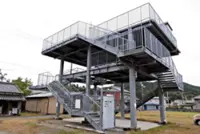From left: US Secretary of Defence Lloyd Austin, US Secretary of State Antony Blinken, Japanese Foreign Minister Yoko Kamikawa and Japanese Defence Minister Minoru Kihara in Tokyo, on July 28.- Reuters
TOKYO: Japan and its security ally, the United States, singled out China as “the greatest strategic challenge in the Indo-Pacific region and beyond” on July 28, as they unveiled their “most significant” defence overhaul to foster better interoperability.
This came as Japanese Foreign Minister Yoko Kamikawa and Defence Minister Minoru Kihara met their respective American counterparts, Antony Blinken and Lloyd Austin, in Tokyo for so-called “two-plus-two” talks.
The quartet, in a joint statement, accused China of seeking to “reshape the international order for its own benefit at the expense of others”, as they criticised its “threatening and provocative” maritime actions and pointed to cooperation between China, North Korea and Russia.
“The PRC (People’s Republic of China) employs political, economic and military coercion of countries, companies and civil society, as well as facilitates its military modernisation through the diversion of technology to achieve these objectives,” they said.
In response to what the ministers described as “the profound level of global threats”, Washington said it will revamp its military command structure in Japan and strengthen the production of American weapons in Japan.
The allies vowed to grow bilateral presence on Japan’s Nansei chain of islands, the westernmost of which lies just 110km from Taiwan, including through joint exercises and shared use of facilities.
They also held their first talks on “extended deterrence”, referring to US commitment to use nuclear arms to protect its allies, as they looked at ways to reinforce bilateral cooperation on “arms control, risk reduction and nonproliferation”.
Nuclear weapons are a sensitive topic in Japan, which is the only country to have suffered atomic bombings. Austin said that the full range of capabilities, including nuclear, would extend over the Senkaku islets administered by Japan and disputed by China, which calls them Diaoyu.
The US-Japan relationship forms the bedrock of what is a clear shift by the US in its traditional “hub-and-spoke” centralised approach towards defence, in favour of a criss-cross of “mini-laterals”, or smaller and more flexible groupings.
Kihara and Austin had, earlier on July 28, also met South Korean counterpart Shin Won-sik in Tokyo, during what was the first South Korean defence ministerial visit to the Japanese capital in 15 years.
They inked a trilateral security pact to “institutionalise” policy consultations, information sharing and joint exercises and make their partnership “unshakable no matter how the international situation changes”, Kihara said.
On July 29, Kamikawa and Blinken will be joined in Tokyo by their counterparts from Australia and India for a Quad security meeting.
Blinken and Austin will then travel to Manila for a “two-plus-two” meeting with their Philippine counterparts, coming just three weeks after Kamikawa and Kihara’s visit to Manila, where they signed a landmark defence deal that allows both nations to hold joint military drills in each other’s territories.
Analysts noted that Japan plays a significant role, given its geographical proximity to potential flashpoints like Taiwan and the South China Sea, as well as to the perceived threats of China, North Korea and Russia.
Beijing and Pyongyang have, whether directly or indirectly, been contributing to Russia’s aggression in Ukraine.
Dr Satoru Nagao, a non-resident fellow at the Hudson Institute think-tank, told The Straits Times that the defence upgrades unveiled on July 28 are “part of a long-term process” to grow security resilience, and will be crucial if multiple conflicts were to happen at the same time.
The joint statement itself recognised Japan’s role “in maintaining peace and security in the Indo-Pacific region by seamlessly responding to any situation from peacetime to contingencies”.
The US will revamp its military command in Japan with a new “joint force headquarters” that will facilitate deeper interoperability with Japan’s Self-Defence Forces.
Japan hosts 54,000 American troops, as well as hundreds of US aircraft and Washington’s only forward-deployed aircraft carrier strike group. Tokyo is separately due to launch a new joint command to oversee its nearly 228,000 personnel by March 2025.
The idea is to ensure that the two militaries are more nimble in case of a regional conflict, given that coordination is being handled from the Indo-Pacific Command in Hawaii, which is 6,500km away and 19 hours behind. This current arrangement may work in peacetime but will be unrealistic in case of a conflict.
Austin said the idea of basing a four-star US commander in Tokyo was something that the Pentagon was “looking at very closely”.
The US also aims to grow defence industrial production with Japan, with American weapon makers stretched by conflicts in Ukraine and the Middle East.
Tokyo and Washington aim to “meet critical demand for advanced (missile) systems, address timely procurement and readiness requirements and deter aggression”, the statement said, by co-producing Advanced Medium-Range Air-to-Air Missiles and Patriot Advanced Capability-3 (PAC-3) air defence missile systems. They will also facilitate ship and aircraft repair.
“American stockpiles are decreasing because they’re supporting Ukraine and Israel. But China’s continues to grow, given that it has only been providing parts for Russia to produce weapons,” Dr Nagao said.
He added that this was not a case of “co-development” – which aims to bolster quality – but rather “co-production”, which aims to grow quantity. - The Straits Times/ANN





